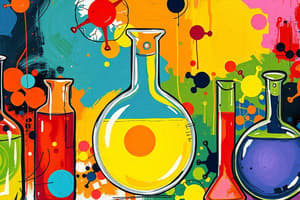Podcast
Questions and Answers
What is a mixture?
What is a mixture?
- The purest forms of matter
- A compound that cannot be broken down
- In nature, matter is mostly found as a combination of substances (correct)
- Contains only one type of atom
What are the purest forms of matter called?
What are the purest forms of matter called?
Substance
Compounds can be broken down into simpler _____
Compounds can be broken down into simpler _____
Elements
A heterogeneous mixture is one where substances are completely or evenly mixed.
A heterogeneous mixture is one where substances are completely or evenly mixed.
What is a solution?
What is a solution?
What is an example of a compound?
What is an example of a compound?
What is an example of an element?
What is an example of an element?
What is an example of a homogeneous mixture?
What is an example of a homogeneous mixture?
What is an example of a heterogeneous mixture?
What is an example of a heterogeneous mixture?
An element contains only one type of atom.
An element contains only one type of atom.
What is settling in terms of mixtures?
What is settling in terms of mixtures?
Flashcards are hidden until you start studying
Study Notes
Mixtures and Substances
- Matter in nature is primarily found as mixtures rather than in pure forms.
- Mixtures consist of multiple substances that retain their individual properties.
Pure Substances
- Substances are the purest forms of matter, consisting of a single kind of material.
Elements
- Elements serve as the building blocks of compounds and cannot be broken down into simpler substances by chemical means.
Heterogeneous Mixtures
- Heterogeneous mixtures contain two or more substances that are not evenly mixed, resulting in distinct layers or phases.
Homogeneous Mixtures
- Solutions represent homogeneous mixtures where two or more substances are uniformly mixed at a molecular level.
Examples of Compounds and Elements
- Water is a prime example of a chemical compound formed from hydrogen and oxygen atoms.
- Copper is a well-known element that exists as a pure substance composed of a single type of atom.
Examples of Mixtures
- Milk is classified as a homogeneous mixture due to the even distribution of its components.
- Blood is an example of a heterogeneous mixture, displaying different components such as cells and plasma that are not uniformly distributed.
Element Characteristics
- An element consists solely of one type of atom, defining its unique chemical properties.
Settling in Mixtures
- Settling commonly occurs in heterogeneous mixtures and leads to the formation of layers based on density differences.
Studying That Suits You
Use AI to generate personalized quizzes and flashcards to suit your learning preferences.




